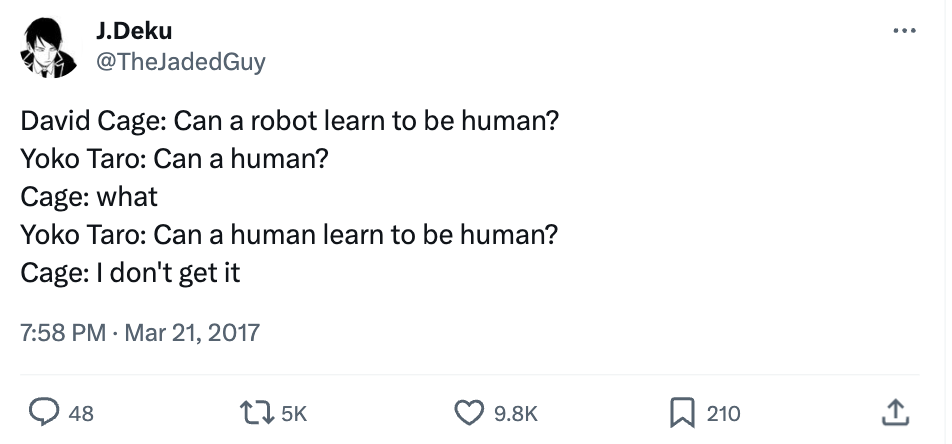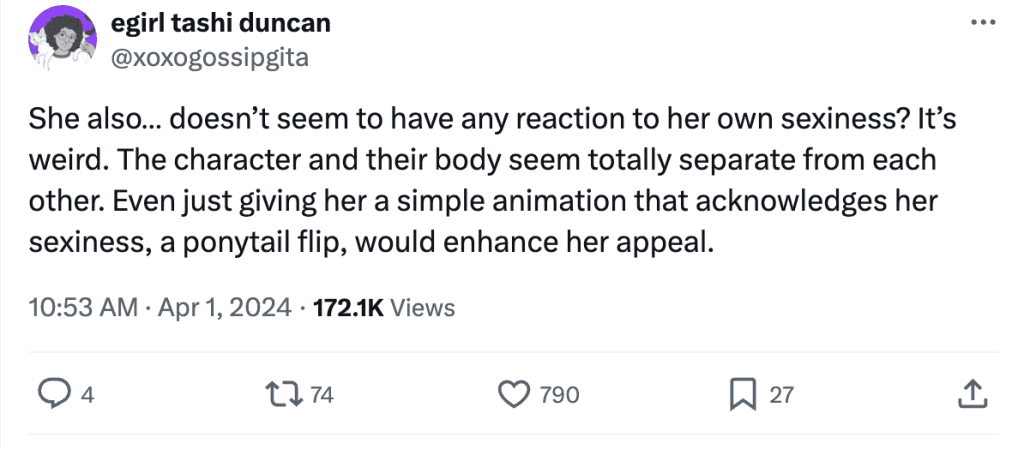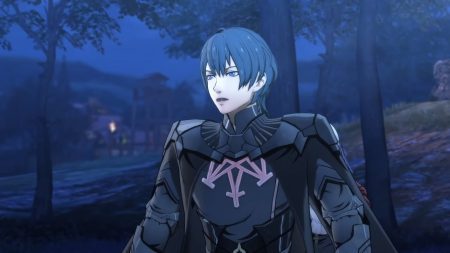This article has spoilers for Stellar Blade, though it is intended to be digestible to those who have no plans to play Stellar Blade.
This article’s structure is inspired by Tom Bissell’s “Thirteen Ways of Looking at a Shooter.”
I.
Just to set the stage: I thought Stellar Blade was a very fun game! Especially for a primarily mobile-focused studio’s first foray into the console space, it’s a worthy and commendable effort, and I’m looking forward to Shift Up’s next release, be that a sequel to Stellar Blade or a new original IP.
Over the course of 40 hours, I thoroughly enjoyed stylishly hacking, slashing, shooting, dodging, and parrying my way through hordes of monsters and robots in a competently aesthetic post-apocalyptic sci-fi universe. With a wealth of text logs and other collectibles scattered around the map and a long list of “run-to-the-quest-marker” sidequests, my playthrough of Stellar Blade was evenly split between main story and side content, all of which I found fun enough to pursue to completion. (There’s something about running around a desert, completing tasks and parrying enemies while a woman gently croons in potential gibberish in the background that just hits, you know?)
(Editor’s note: Embedded videos are gameplay recordings from the author.)
The setting and story are, to borrow a fellow site writer’s favorite word, cromulent. Players who are more enmeshed within sci-fi as a genre will likely find the setups and reveals of Stellar Blade’s story to be fairly standard fare. The game also isn’t exactly shy with its obvious foreshadowing, which exists not just in the story but in the degree to which it nakedly partakes in its inspirations. Large chunks of the plot and history of the world are revealed through the incessantly video-gamey drip feed of transcribed memory sticks, text logs, and other collectibles.
Generally, the written dialogue and dub performances left something to be desired, though I cut everyone involved some slack given that translation and budget are likely to be issues that a foreign studio’s first foray into the console game would suffer.
Despite all of this, I found that Stellar Blade played its hand—as far as the overarching narrative goes—so straightforwardly that it was almost refreshing…or maybe this is just the Stockholm syndrome speaking. Ultimately, the cast of characters that EVE comes to know—including EVE herself—is just lovable enough to care about saving.
Of course, the meat and potatoes of Stellar Blade is the combat. It seems impossible to describe action games these days without analogizing them to some cocktail made out of FromSoftware ingredients, so here goes: it’s Sekiro: Shadows Die Twice (2019).
Okay, that was excessively glib. There are some structural differences. First, enemies don’t just have posture, but also have regenerating shield health. Second, EVE has more basic attack strings than Sekiro’s protagonist, Wolf, as well as a more prominent ranged attack option. But the overall cadence of combat feels similar—parry, attack, parry, dodge, attack, parry, visceral.
EVE even has special abilities that key off of a resource that is replenished through combat, similar to the way Shinobi Prosthetics required Spirit Emblems to use. Her special attacks have a flashiness and flair to them that is reminiscent of Devil May Cry, at least visually if not in terms of required technical mastery.
True action game aficionados might find Stellar Blade’s combat to be…prescriptive. Yellow flash, dodge, blue flash, dodge forward, purple flash, dodge back, parry, parry, parry. EVE and her enemies have pretty strong target tracking, which has a tendency to render spacing entirely moot. An example of this phenomenon is EVE’s evade: successfully dodging immediately puts her into a slowed-down counterattack window that sees her flying toward the enemy regardless of distance.
Stellar Blade is clear in how it operates. What you see is what you get, and any similarities to other media that exist don’t feel born out of a desire to steal an idea, replicate it, and play it off as something unique or original. It’s just that: an appreciation and love, often displayed on surface level, for those that came before it.
If you argued that the game largely comes down to reaction skill checking, I couldn’t entirely disagree, though there is some depth in how to optimize damage for certain tight windows because her basic attack strings differ widely and can leave her susceptible. Truthfully, playing Stellar Blade feels like it’s more about mastering enemies than it is about the combat system.
Despite those caveats, the combat feels satisfying and looks very good, with a depth and complexity that is proportional to the game’s runtime (20+ hours). Nioh 2 and its dozens of hours required to achieve even a moderate level of proficiency, this is not.
Also, unlike Wolf, EVE is a conventionally attractive woman in a very tight skinsuit. I feel like I buried that lede. That’s what we’re all talking about, right?
II.
“There was some kind of lore behind Eve showing a lot of interest in the costumes that were left behind on the surface of Earth. We did have that concept, and it was part of her character, but then we later decided that this doesn’t really have to be shown in the game.”
Hyung-Tae Kim, director of Stellar Blade in an interview with Game Informer
It fucking kills me that they took this out.
III.
As I mentioned earlier, Stellar Blade plays its hand so straightforwardly that it’s almost refreshing, and nowhere is that more apparent than in the love it shows to its influences. Director Hyung-Tae Kim has stated that he was inspired by many things, but “mainly manga, anime and games from the 1980s and ’90s,” specifically naming Battle Angel Alita, Ghost in the Shell, Neon Genesis Evangelion, and Blade Runner as inspirations.
So, of course, when EVE interacts with the humans on Xion, the last safe haven for mankind on Earth, they call her “Angel.” She wears a skintight Nano Suit clearly inspired in part by the plugsuits from Evangelion; she walks amongst the mechanically enhanced humans of Xion, who often have cybernetics masks, eyes, and limbs reminiscent of the populace in Ghost in the Shell. At one point, a text log literally refers to a character seeking out the “Angel’s Egg.”
EVE has multiple one-winged forms reminiscent of a certain video game icon; in the final act, a man naked from the waist up faces you down. Minutes later, EVE performs a finishing blow that could perceivably be viewed as an Omnislash:
References aren’t just visual or aesthetic, either. Kim named Blade Runner as one of his inspirations, so those familiar with the film might be able to predict one of the final “revelations” EVE is forced to face about herself.
I could understand that some players may be put off by this sort of thing, but Stellar Blade is clear in how it operates. What you see is what you get, and any similarities to other media that exist don’t feel born out of a desire to steal an idea, replicate it, and play it off as something unique or original. It’s just that: an appreciation and love, often displayed on the surface level, for those that came before it.
Also, her name is EVE and the second character you meet (and your first permanent companion) is named Adam, so, you might be able to guess where this is going.

IV.
If I had a nickel for every time I played a game where I played a sexy blade-wielding woman with characters named Adam and Eve, I’d have two nickels. Which isn’t a lot, but it is weird that it’s happened twice.
There was one obvious inspiration that I neglected to mention because I felt it deserved special mention: the inimitable NieR: Automata. It’s an understatement, however, to label Automata’s influence on Stellar Blade as mere inspiration. Conception would be more accurate:
“Nier: Automata left a huge impression on me […] It made me realize that a game like this could be made, and allowed me to rediscover the kind of game that I want to make.”
Hyung-Tae Kim, director of Stellar Blade in an interview with Game Informer
Both games share numerous superficial similarities: a powerful female warrior in unique attire with a blade battling her way through a devastated world with pockets of survivors, a chatty (or in Adam’s case, slightly chattier) male companion, a floating droid. There’s even overlap in the music, with Studio MoNaCa doing the soundtrack for both games. (Studio MoNaCa is comprised of a number of composers, to my knowledge there isn’t direct overlap between these two projects, but there are obvious stylistic similarities.) While the play experience differs quite a bit, both games are loosely pseudo-hack-and-slash action games with some level of customization, so they fall into similar buckets.
But Hyung-Tae Kim and Yoko Taro, the auteur director of NieR: Automata, present each game quite differently. In an IGN Japan interview featuring the two directors, Taro adopted his typical demeanor of effusive praise towards other games paired with self-deprecating assessments of his own work, saying Stellar Blade is “much better than NieR: Automata.” Meanwhile, Kim is open about where he feels Stellar Blade falls short in comparison.
“For me, NieR: Automata is like an inviolable holy grace. The visuals and story are so special that it is simply not possible to imitate,” Kim says, and he’s correct. Stellar Blade isn’t pure shlock, but it doesn’t come close to the narrative and emotional heights of Automata. To its credit, it doesn’t seem like it’s trying to be, either. Still, as my high school teachers used to say, lack of effort is just a reason, not an excuse.
I’m reminded of a semi-viral tweet that made the rounds years ago when Automata first came out.

I’m not sure how the Hyung-Tae Kim version of this tweet reads. I’m workshopping it.
V.
Playing this game reminded me of an old video essay I’d seen years ago—“Framing Megan Fox: Feminist Theory Part 3” by Lindsay Ellis.
The video goes into the specifics, but the gist of it is that in the movie Transformers (2007), there is a severe discrepancy between the character of Mikaela (portrayed by Megan Fox) as presented in the script versus the way the audience remembers her, largely because of the way the camera frames her—which is to say as eye candy instead of as a character with agency that the audience should treat with respect.
As Ellis puts it: “When you have a director who is much more interested in frame for frame’s sake rather than using the camera to emphasize storytelling, …the narrative, the character, and the theme are at war with the aesthetics […] because this is a visual medium, what the audience remembers is what the camera tells them.”
EVE suffers from an extension of this problem. If Mikaela’s visual framing is at odds with her character, EVE’s framing seems to be completely divorced from her character entirely. Mikaela wants to be taken seriously for her expertise and skill, not her body; EVE seems to be almost completely unaware that she has a body worth envying at all. Which begs the questions: is it worse to be transgressive, or jarringly incongruous?

This dissonance comes into even sharper focus when you play the game and realize that almost no one seems to view EVE this way. From my experience playing the game, I can think of only one or two instances in which EVE’s sexiness was even hinted at or acknowledged at all. There are times Airborne Squad Members (the strike force EVE and her compatriots belong to) are referred to in a worshipful manner, which is not quite the same.
EVE seems blithely unaware of her appearance, and weirdly, so does everyone else in this universe. This further emphasizes what appears to be a fundamental rule: EVE is hot, but for only two people. The camera, and you.
The final product is a cinematic experience occasionally akin to whiplash: EVE will be doing veritable badass things, flipping, slicing, dicing, and decapitating, then you’ll get an insane slo-mo shot of her ass, then she’ll deliver spectacularly gory and awesome killing blow.
The framing of certain shots in cutscenes (often exacerbated by the variety of outfits EVE can don—some shots that are more feasible in a bodysuit become quite jarring in a jean skirt) focuses on EVE and her sex appeal. Simultaneously, the utter lack of acknowledgement of such from EVE or the characters and world she interacts with creates an uncanny valley of voyeuristic spectacle. The reality of Stellar Blade is that the cinematic language of the camera is completely separate from the narrative writing of the character, and the aesthetic appearance of the character is almost entirely unrecognized by the world around her.
To head off an inevitable counterpoint of “why can’t she just be sexy,” well—she can! (Certainly not a thing we’re opposed to just for the sake of opposition.) But for an aspect of the game that is so front and center—functionally and in the marketing—it just seems like a bit of a missed opportunity to absolutely never engage with it on a character or worldbuilding level. If Bayonetta can pose and wink at the camera and Kainé can kick the shit out of it, EVE can at least acknowledge its existence.
VI.
I really want to reiterate that any game that lets you cosplay as Vergil in a jean skirt is awesome, and that I think this game rocks.
VII.
Circling back to EVE for a moment.
There is the obviously allegorical connection to be made between EVE and, well…Eve, from the Bible. The only authors I know who use subtext are cowards, after all. Gene Park at the Washington Post even posited that EVE is “bland by design, an obvious metaphor for the creation myth who gains personhood through the forbidden fruit of knowledge.” I think this is a fair take, but also an overstated one. I can acknowledge the merits of a good allegorical tale, but I’m not sure the points truly align here.
In most tellings of the tale, the biblical Eve is naive and innocent, living happily in the Garden of Eden until she is tempted by the serpent and partakes in the fruit of a forbidden tree. This fruit provides Adam and Eve with knowledge of evil, of shame, the things that in part define our personhood—but they are cast out of the garden by God for their sins.
Does any of this actually track with the narrative of Stellar Blade? The forbidden knowledge that EVE gains is not personhood but rather the realization of anti-personhood—the truth that she is not human, but an Andro-Eidos, an android approximation of a human. EVE isn’t tempted by the knowledge of her true nature, she’s tormented by it. Her starting point also isn’t as a naive innocent raised in an idyllic and beautiful paradise of peace: she’s a soldier.
At the end of the game, EVE faces a final choice: to take Adam’s hand or reject it. Should she choose the former, the two merge into one and become the origin point for a new kind of human species—an ideal union of organic evolution and mechanical perfection, the marriage of essence and form. Since EVE is an Andro-Eidos, were the Andro-Eidos intended to be naive and innocent in relation to the original humans?
Alternatively, EVE can rebuff Adam’s offer, doom the original human race, and confront Mother Sphere. I suppose in this analogy Adam is both representative of the biblical Adam and the serpent, offering a choice that goes against the wishes of God/Mother Sphere?
As a minor tangent, EVE bizarrely chooses this moment to kickstart her self-empowerment arc:
Obviously, I would normally applaud such a character development, but having your girlboss awakening as you choose to commit genocide is certainly… a choice?
Overall, the optics here are a little strange. I’m not sure that the narrative intended to conflate EVE’s personhood and agency with the destruction of a sapient race, but here we are.
Ultimately, it’s difficult to put too much stock in this allegory because it doesn’t feel as if the allegorical beats actually track. Does EVE gain more agency as the story progresses? Yes, I’d say so, albeit in a rather rote way. Does she become more “human”? She grows closer to Adam and Lily of the 5th Airborne, but just barely, and often the game feels like it’s relying on the assumption that you believe this trio has developed camaraderie as opposed to actually showing it. Truthfully, she was always altruistic and well-meaning, diverting from her primary quest often to take on side quests, so it’s not as if her range of empathy grew significantly in this respect either.
It feels like the writers started with a vibe—Adam and EVE as the potential progenitors of mankind—and just worked backward from there without too much care for the all-too-vital interstitial connective tissue of the story or their allegory. The end result is a feeling that’s all too common when you inspect Stellar Blade closely: a realization of the priorities of this game, where efforts were made and where they were not.
Closing thought: I have a pet theory that EVE’s original characterization may have aligned more closely to the biblical Eve, as the reveal trailer from 2019 shows a much more baby-faced and younger-looking EVE. Admittedly, she’s still clearly a determined soldier character in a skintight bodysuit and the camera lingers on her ass, so who can say.
VIII.
Look at how happy EVE is here to find this can. I love that for her. I think this might be the happiest she ever is in this game.
IX.
EVE’s character has inspired numerous and varied reactions, but the one consensus that has solidified is that she is, well…boring. IGN’s Mitchell Saltzmann admitted that “after 30 hours I can barely tell you anything noteworthy about Eve outside of the fact that she’s fiercely dedicated to her mission…it was hard to become invested in Eve, her mission, or Stellar Blade’s world in general.” Matt Miller at Game Informer wrote, “Eve is mostly a blank slate of a character, and it’s disappointing that we see so little character development throughout her lengthy adventure.” At Eurogamer, Jessica Orr described EVE’s personality as “[boiling] down to her saying “Okay” or “Alright” to everything.”
I can’t begrudge anyone for feeling this way. Some of EVE’s most emotive moments were probably in the very first scene with Tachy, a soldier from the 7th Airborne, where it’s clear EVE genuinely cares for Tachy, culminating in anguish when Tachy seemingly perishes during their catastrophic orbital assault. Sadly, as Tachy exits the story, so too does EVE’s emotional output. She quickly settles into a steady pattern of repeatedly stating her commitment to her mission—to destroy or capture the Elder Naytiba—and bluntly accepting and fulfilling side quests.
Still, in the name of positivity, I do want to highlight some aspects of her character I enjoyed. One of the few times EVE expresses clear disgust or distaste for something is swimming. She truly despises getting wet, and it was a nice quirk to include given her typical highly stoic, staid, and steadfast soldier persona.
It’s unfortunate that, as referenced earlier, elements of EVE’s character relating to her interest in surface Earth fashions or objects were removed. Her fascination with collectible aluminum cans and the proud, fourth-wall-breaking pose she strikes when she finds them is a cute highlight.
Additionally, she has her fair share of amusing interactions with quest-givers. Unfortunately, EVE delivers a fair number of these solely through text responses when bulletin board missions are submitted. She seems generally more expressive over text than with her voice, which might be an issue with the voice direction for the actor. There’s also a blunt straightforwardness to some of her responses that added a humorous element to a character who largely vacillates between stoicism and quiet badassery, though I truly can’t speak to how intentional these are.
While the voice performances in this game generally aren’t anything to write home about, one element I do want to shout out is that while EVE is very cool and very badass, she isn’t effortless. On the scale of high-kill-count women protagonists, she’s much closer to Survivor trilogy Lara Croft than Bayonetta’s suave and smooth style. She labors to open heavy-duty supply crates, gets thrown off-balance opening stuck doors, and grunts in frustration and exertion during cinematic kills. Her momentum often launches her forwards, backward, and all over the place, she slides in a shower of centrifugal sparks to pivot and recenter, and she’ll grind her blade into metal to anchor herself against her momentum.
That’s not to say she doesn’t have some moments of pure feel-good badassery and destruction, but placing her in the ballpark of an incredibly acrobatic and precise gymnast as opposed to a gravity-defying being, unbeholden to the laws of nature, feels appropriate. I think framing her more like Bayonetta or Dante would have been a mistake. All of this struggle provides a more human and grounded element to the spectacle of her combat.
Finally, it helps that EVE is, at her core, an altruistic person, which at least means you can root for her success. She might not be the most interesting character, but at least you won’t feel bad about what you’re doing.
Despite EVE’s misgivings about certain situations, she is always willing to listen to requests, put herself in danger, and extend a helping hand. Fetching the memory stick of a lost loved one is of no consequence compared to her stated objective to kill the Elder Naytiba, but she does it anyway. Even when she is presented with insecurities about the true history of humanity or her own nature, EVE compartmentalizes quickly, keeps her eyes on the prize, and refuses to be weighed down by cynicism or despair. It’s not the most fleshed-out characterization in the world, but it is refreshing! (Of course, maybe the fact that her altruism is already concretely set in stone contributes to the overall feeling of EVE lacking character development, but I digress).
X.
“Yes, the Bible […] it does have to do with the themes of the plot as well, but then ultimately, at the end of the day, this is an action-adventure game so when the players play this game, they can just take this [connection] lightly and just enjoy the game.”
Hyung-Tae Kim, director of Stellar Blade
XI.
Obviously, I was the fool for taking this so seriously.
Huge video game, comic book, and anime fan. Spends way too much time watching things he doesn’t like. Hates Zack Snyder. Mains Falco.














